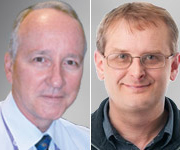TELEMEDICINE — the use of information and communications technology to provide health care at a distance — has evolved significantly in the past 2 decades.
Now, with the introduction of Medicare Benefit Schedule (MBS) item numbers for video-based GP-to-specialist consultations, the use of telemedicine is spreading from the public hospital setting to the private sector. MBS items provide an incentive for clinicians to make better use of telemedicine services.
Neonatal care exemplifies the healthcare impediments of distance and time and the advantages telemedicine may provide.
In Queensland 54% of all livebirths and 27% of all high-risk births occur in hospitals more than 50 km from the state’s three tertiary hospital nurseries.
The mean time to reach a sick infant is 2 hours, during which time support has traditionally been provided by telephone alone.
Over some years we have been examining whether the addition of an audiovisual consultation can improve the clinical management of sick infants. While still at the observational stage, evidence is building that telemedicine can allow earlier intervention and avoid some retrievals resulting in cost savings to the health system.
Our experience shows that to improve care in acute medical settings, telemedicine must meet a number of requirements and it must be able to be quickly, reliably and easily used by clinicians without specific technical knowledge.
Ideally, the regional clinician using telemedicine should be able to discuss the patient hands-free with initiation and camera activity controlled by the specialist site.
Telemedicine must also suit the clinical environment — it must have a small footprint, be easily positioned close to the patient and be able to transmit data or capture views of medical equipment and images.
Well-designed systems allow the remote clinician a precise view, including tube placements, respiratory distress signs and monitoring screens. The ability to immediately view remote x-rays has clear benefits for the patient.
Paediatric telemedicine is well established in Queensland where most experience relates to outpatient consultations. The University of Queensland Centre for Online Health, based at the Royal Children’s Hospital, Brisbane, has conducted more than 13 500 teleconsultations, across 37 subspecialties, for children in 104 regional, rural and remote hospitals.
The telepaediatric service, established in 1999, provides a centralised clinical coordination function and guarantees a specialist response, where appropriate within 24 hours.
Telemedicine’s greatest use has been in the follow-up of chronic paediatric conditions such as post-acute burns care and diabetes where support may be required for years after discharge.
As a discipline, telemedicine is undergoing a long and difficult gestation and it will be some time before it is routine practice in many settings. While evidence in favour of telemedicine is not yet strong, clinical benefits and cost savings have been demonstrated, both for patients and for the health system.
Patients and clinicians who have been exposed to telemedicine are largely supportive. However, beyond the enthusiasts, clinicians are generally hesitant to adopt, with concerns around safety, clinical effectiveness and efficiency.
While MBS rebates have been long awaited and provide an incentive to use telemedicine, more initiatives are needed to expand this service. These include convincing evidence of clinical effectiveness and safety in a range of settings; telemedicine that is easy, reliable and efficient for busy clinicians to use; funding for clinician time as well as telemedicine infrastructure; and appropriate tools to schedule providers and patients, and securely share medical information at a distance.
Work to address some of these issues is under way and the future of telemedicine looks good.
Telemedicine will eventually become routine, offering benefits to patients, to providers and to society as a whole.
Dr Tim Donovan is a senior lecturer in the University of Queensland, researcher in the Perinatal Research Centre at the University’s Centre for Clinical Research, and a neonatal paediatrician at the Royal Brisbane and Womens’ Hospital. Dr Nigel Armfield is a research fellow with a particular interest in neonatal and paediatric intensive care telemedicine. He is based at the University of Queensland Centre for Online Health at the Royal Children’s Hospital, Brisbane.
Posted 27 February 2012

 more_vert
more_vert